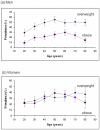Prevalence of obesity and the relationship between the body mass index and body fat: cross-sectional, population-based data
- PMID: 22253741
- PMCID: PMC3258232
- DOI: 10.1371/journal.pone.0029580
Prevalence of obesity and the relationship between the body mass index and body fat: cross-sectional, population-based data
Abstract
Background: Anthropometric measures such as the body mass index (BMI) and waist circumference are widely used as convenient indices of adiposity, yet there are limitations in their estimates of body fat. We aimed to determine the prevalence of obesity using criteria based on the BMI and waist circumference, and to examine the relationship between the BMI and body fat.
Methodology/principal findings: This population-based, cross-sectional study was conducted as part of the Geelong Osteoporosis Study. A random sample of 1,467 men and 1,076 women aged 20-96 years was assessed 2001-2008. Overweight and obesity were identified according to BMI (overweight 25.0-29.9 kg/m²; obesity ≥30.0 kg/m²) and waist circumference (overweight men 94.0-101.9 cm; women 80.0-87.9 cm; obesity men ≥102.0 cm, women ≥88.0 cm); body fat mass was assessed using dual energy X-ray absorptiometry; height and weight were measured and lifestyle factors documented by self-report. According to the BMI, 45.1% (95%CI 42.4-47.9) of men and 30.2% (95%CI 27.4-33.0) of women were overweight and a further 20.2% (95%CI 18.0-22.4) of men and 28.6% (95%CI 25.8-31.3) of women were obese. Using waist circumference, 27.5% (95%CI 25.1-30.0) of men and 23.3% (95%CI 20.8-25.9) of women were overweight, and 29.3% (95%CI 26.9-31.7) of men and 44.1% (95%CI 41.2-47.1) of women, obese. Both criteria indicate that approximately 60% of the population exceeded recommended thresholds for healthy body habitus. There was no consistent pattern apparent between BMI and energy intake. Compared with women, BMI overestimated adiposity in men, whose excess weight was largely attributable to muscular body builds and greater bone mass. BMI also underestimated adiposity in the elderly. Regression models including gender, age and BMI explained 0.825 of the variance in percent body fat.
Conclusions/significance: As the BMI does not account for differences in body composition, we suggest that gender- and age-specific thresholds should be considered when the BMI is used to indicate adiposity.
Conflict of interest statement
Figures


References
-
- Quetelet LAJ. Physique sociale 2, p92. Brussels: C. Muquardt; 1869.
-
- Keys A, Fidanza F, Karvonen MJ, Kimura N, Taylor HL. Indices of relative weight and obesity. J Chronic Dis. 1972;25:329–343. - PubMed
-
- Flegal KM, Carroll MD, Ogden CL, Johnson CL. Prevalence and trends in obesity among US adults, 1999–2000. JAMA. 2002;288:1723–1727. - PubMed
-
- Rennie KL, Jebb SA. Prevalence of obesity in Great Britain. Obes Rev. 2005;6:11–12. - PubMed
-
- Cameron AJ, Welborn TA, Zimmet PZ, Dunstan DW, Owen N, et al. Overweight and obesity in Australia: the 1999–2000 Australian Diabetes, Obesity and Lifestyle Study (AusDiab). Med J Aust. 2003;178:427–432. - PubMed
Publication types
MeSH terms
LinkOut - more resources
Full Text Sources
Medical
Research Materials

